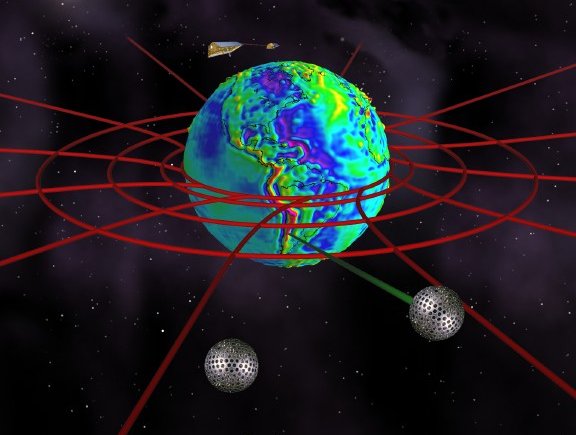The Gravity Recovery and Climate Mission (GRACE) helps in testing the effects predicted by Einstein’s theory of relativity. One of these effects is the Lense-Thirring effect or frame dragging effect: a satellite orbiting around Earth is dragged by Earth’s rotation like honey by a twisted spoon. So once a satellite has finished one rotation around Earth, it will not reach the same position where it started but it will slightly be displaced. These offsets are extremely small.
In order to measure those, a team of scientists from Italy, USA, Great Britain, Armenia and from the GFZ German Research Centre for Geosciences uses a trick: they combine the data of the satellites LAGEOS-1 und -2 and, for the first time, the data of LARES (Laser Relativity Satellite) which was launched in 2012 with exactly the purpose to improve the measurement of frame dragging. All satellites are tracked by "Satellite Laser Ranging" (SLR), GFZ is also running a SLR station within an international network. The combination of the data needs highly precise models of the distribution of gravity. These models are based on meanwhile more than 14 years of observations by the satellite mission GRACE where GFZ contributes operationally. With this approach the scientists recently improved the test of the Lense-Thirring effect and even made it to the front page of the high ranking European Physical Journal C in March.
20.07.2016, Franz Ossing
Ignazio Ciufolini, Antonio Paolozzi, Erricos C. Pavlis, Rolf König, John Ries, Vahe Gurzadyan, Richard Matzner, Roger Penrose, Giampiero Sindoni, Claudio Paris, Harutyun Khachatryan, Sergey Mirzoyan: "A test of general relativity using the LARES and LAGEOS satellites and a GRACE Earth gravity model", Eur. Phys. J. C (2016) 76: 120. doi:10.1140/epjc/s10052-016-3961-8








![[Translate to English:] Torsten Sachs in front of a climate station on a field](/fileadmin/_processed_/3/9/csm__TorstenSachs_bearbeitet_GS_4a1365ef84.jpeg)

![[Translate to English:] left image flood at the Ahrtal: image from above, several houses are flooded; left image:: Heidi Kreibich;](/fileadmin/_processed_/4/4/csm_Bild2_9af0130e9f.png)



![[Translate to English:] Start der Vega Rakete](/fileadmin/_processed_/6/4/csm_20231201-kachel_Vega-VV23-launch_ESA-CNES-Arianespace_706716b68c.jpeg)









![[Translate to English:] Poster exhibition at the Brandenburg Hydrogen Day at the GFZ, some participants in the foreground](/fileadmin/_processed_/6/5/csm_Erster_Brandenburgischer_Wasserstofftag_GFZ_402fcec95e.jpeg)
![[Translate to English:] Group picture of the participants](/fileadmin/_processed_/9/4/csm_20231108_CAWa-Workshop-Tashkent_Gruppenbild_99ea779d8a.jpeg)

![[Translate to English:] [Translate to English:] Hörsaal](/fileadmin/_processed_/e/6/csm_H%C3%B6rsal_e21ac645fb.jpeg)


![[Translate to English:] The Delegations in the Historic Library on the Telegrafenberg. In the back there are from left to right, the Dutch Ambassador for Germany, Ronald van Roeden, the Dutch Minister for Education, Culture and Science, Robbert Dijkgraaf and the scientific director of the GFZ, Susanne Buiter.](/fileadmin/_processed_/d/b/csm_Kachel-2_9eba4b4212.jpeg)

